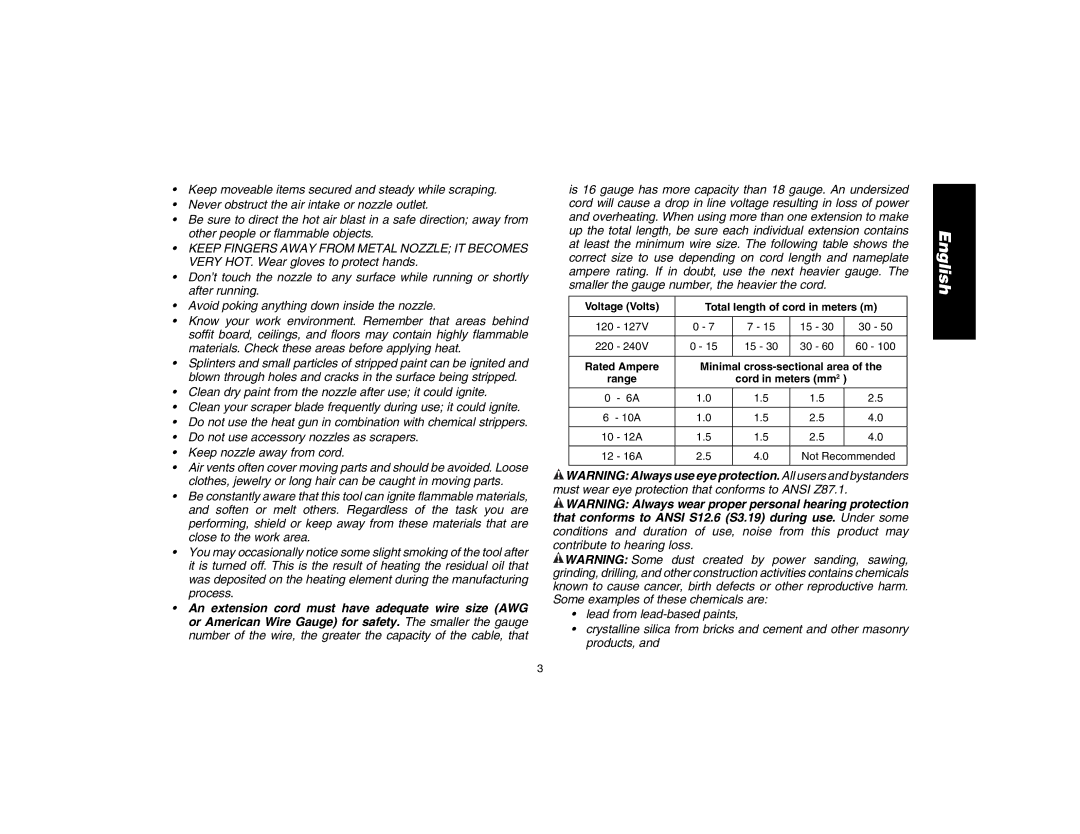•Keep moveable items secured and steady while scraping.
•Never obstruct the air intake or nozzle outlet.
•Be sure to direct the hot air blast in a safe direction; away from other people or flammable objects.
•KEEP FINGERS AWAY FROM METAL NOZZLE; IT BECOMES VERY HOT. Wear gloves to protect hands.
•Don’t touch the nozzle to any surface while running or shortly after running.
•Avoid poking anything down inside the nozzle.
•Know your work environment. Remember that areas behind soffit board, ceilings, and floors may contain highly flammable materials. Check these areas before applying heat.
•Splinters and small particles of stripped paint can be ignited and blown through holes and cracks in the surface being stripped.
•Clean dry paint from the nozzle after use; it could ignite.
•Clean your scraper blade frequently during use; it could ignite.
•Do not use the heat gun in combination with chemical strippers.
•Do not use accessory nozzles as scrapers.
•Keep nozzle away from cord.
•Air vents often cover moving parts and should be avoided. Loose clothes, jewelry or long hair can be caught in moving parts.
•Be constantly aware that this tool can ignite flammable materials, and soften or melt others. Regardless of the task you are performing, shield or keep away from these materials that are close to the work area.
•You may occasionally notice some slight smoking of the tool after it is turned off. This is the result of heating the residual oil that was deposited on the heating element during the manufacturing process.
•An extension cord must have adequate wire size (AWG or American Wire Gauge) for safety. The smaller the gauge number of the wire, the greater the capacity of the cable, that
is 16 gauge has more capacity than 18 gauge. An undersized cord will cause a drop in line voltage resulting in loss of power and overheating. When using more than one extension to make up the total length, be sure each individual extension contains at least the minimum wire size. The following table shows the correct size to use depending on cord length and nameplate ampere rating. If in doubt, use the next heavier gauge. The smaller the gauge number, the heavier the cord.
Voltage (Volts) | Total length of cord in meters (m) | |||||
|
|
|
|
|
|
|
120 | - 127V | 0 - 7 | 7 - 15 | 15 - 30 |
| 30 - 50 |
|
|
|
|
|
|
|
220 | - 240V | 0 - 15 | 15 - 30 | 30 - 60 |
| 60 - 100 |
|
|
|
|
| ||
Rated Ampere | Minimal | |||||
range |
| cord in meters (mm2 ) |
| |||
0 | - 6A | 1.0 | 1.5 | 1.5 |
| 2.5 |
|
|
|
|
|
|
|
6 | - 10A | 1.0 | 1.5 | 2.5 |
| 4.0 |
|
|
|
|
|
|
|
10 | - 12A | 1.5 | 1.5 | 2.5 |
| 4.0 |
|
|
|
|
|
| |
12 | - 16A | 2.5 | 4.0 | Not Recommended | ||
|
|
|
|
|
|
|
![]() WARNING: Always use eye protection. All users and bystanders must wear eye protection that conforms to ANSI Z87.1.
WARNING: Always use eye protection. All users and bystanders must wear eye protection that conforms to ANSI Z87.1.
![]() WARNING: Always wear proper personal hearing protection that conforms to ANSI S12.6 (S3.19) during use. Under some conditions and duration of use, noise from this product may contribute to hearing loss.
WARNING: Always wear proper personal hearing protection that conforms to ANSI S12.6 (S3.19) during use. Under some conditions and duration of use, noise from this product may contribute to hearing loss.
![]() WARNING: Some dust created by power sanding, sawing, grinding, drilling, and other construction activities contains chemicals known to cause cancer, birth defects or other reproductive harm. Some examples of these chemicals are:
WARNING: Some dust created by power sanding, sawing, grinding, drilling, and other construction activities contains chemicals known to cause cancer, birth defects or other reproductive harm. Some examples of these chemicals are:
•lead from
•crystalline silica from bricks and cement and other masonry products, and
English
3
